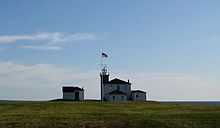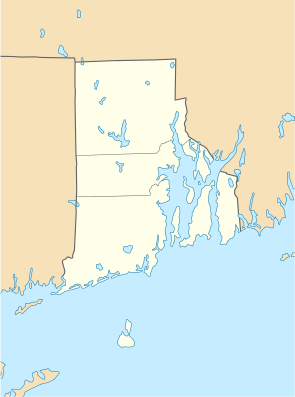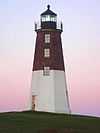Watch Hill Light
 | |
 | |
| Location | Watch Hill, Rhode Island |
|---|---|
| Coordinates | 41°18′14″N 71°51′30.3″W / 41.30389°N 71.858417°WCoordinates: 41°18′14″N 71°51′30.3″W / 41.30389°N 71.858417°W |
| Year first constructed | 1808 |
| Year first lit | 1857 (current tower) |
| Automated | 1986 |
| Foundation | Granite block |
| Construction | Granite with brick interior |
| Tower shape | Square |
| Markings / pattern | Natural w/ white lantern, red roof |
| Height | 61 feet (19 m) |
| Focal height | 61 feet (19 m) |
| Original lens | 4th order Fresnel lens |
| Current lens | VRB-25 |
| Range | 14 nautical miles (26 km; 16 mi) |
| Characteristic | Alternating R&W, 5s |
| Fog signal | Horn: 1 every 30s |
| USCG number | [3] |
The Watch Hill Lighthouse in Watch Hill, Rhode Island, has served as a nautical beacon for ships since 1745, when the Rhode Island colonial government erected a watchtower and beacon during the French and Indian War and Revolutionary War. Destroyed in a 1781 storm, plans were discussed to build a new lighthouse to mark the eastern entrance to Fishers Island Sound and to warn mariners of a dangerous reef southwest of Watch Hill.
President Thomas Jefferson signed an act to build the lighthouse in 1806 and construction was completed in 1807. The first lighthouse stood 35 feet (11 m) tall.
In 1827 a rotating light was installed to differentiate the light from that of the Stonington Harbor Light in Connecticut. Erosion forced the lighthouse to close in 1855 and move further away from the bluff edge.
The next lighthouse, opened in 1856, stands 45 feet (14 m) tall. Sixteen years later the steamer Metis crashed off Watch Hill in 1872 killing 130 people. A United States Life-Saving Service station was built next to the lighthouse where it operated until the 1940s and was destroyed in 1963. In 1873 Captain Jared Starr Crandall, keeper of the lighthouse, was awarded the Congressional Gold Medal for rescue operations involving the Metis. In 1879, Capt. Crandall's widow, Sally Ann (Gavitt) Crandall, became the first woman lighthouse keeper there.
In 1907, the steamer Larchmont collided with a schooner killing 200 people four miles from the lighthouse. The Hurricane of 1938 caused severe damage to the lighthouse. The Leif Viking ran aground a few hundred feet from the lighthouse in 1962, and although there were no injuries, the ship was stranded for nine days. The lighthouse was automated in 1986 and leased to the Watch Hill Lightkeepers Association.
See also
References
- ↑ Light List, Volume I, Atlantic Coast, St. Croix River, Maine to Shrewsbury River, New Jersey (PDF). Light List. United States Coast Guard. 2009. p. 180.
- ↑ Rowlett, Russ (2010-03-10). "Lighthouses of Rhode Island". The Lighthouse Directory. University of North Carolina at Chapel Hill.
- ↑ "Historic Light Station Information and Photography: Rhode Island". United States Coast Guard Historian's Office.
